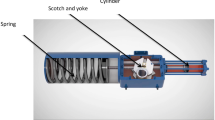Conclusions
1. The massager can pump up to 7 liters/min and effectively replace the heart function.
2. The factors that reduce the massager's productivity are: A mismatch between the dimensions of the massager and a heart; the massager is badly held on the heart by the vacuum suction; the vacuum capacity of the pneumatic drive is inadequate.
3. Massagers of the design investigated permit the heart to fill passively in the diastole at a rate determined only by the precardiac pressure regardless of the degree of vacuum in the air cavity of the massager. This factor also limits productivity.
4. It is advisable to use massagers in vivo that have a productivity of less than 5 liters/min at a rate of 100 ppm.
Similar content being viewed by others
Literature cited
V. I. Shumakov et al., in: Problems of Transplantation and Artificial Organs [in Russian], Moscow (1977), pp. 11–16.
T. L. Egorov et al., Med. Tekhnika, No. 4, 57–59 (1976).
Author information
Authors and Affiliations
Rights and permissions
About this article
Cite this article
Egorov, T.L., Itkin, G.P., Parashin, V.B. et al. Investigation of the pumping function in devices for direct mechanical cardiomassage. Biomed Eng 14, 28–30 (1980). https://doi.org/10.1007/BF00557449
Received:
Issue Date:
DOI: https://doi.org/10.1007/BF00557449




